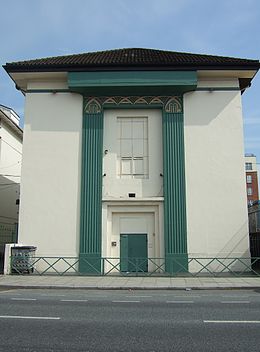Dublin United Tramway Company Powerhouse
|
Historic Dublin United Tramway Company Powerhouse building in Dublin's Docklands |
|
| The New Windmill Lane Studios | |
| Protected Structure in Dublin | |
| Registration number.: | 7381 |
| location | |
| Address: | 20 Ringsend Road |
| District: | Dublin 4 |
| Coordinates: | 53 ° 20 '31.8 " N , 6 ° 14' 4.7" W |
| map | |
| history | |
| Construction year: | 1932 |
| architecture | |
| Architect: | Vincent Kelly |
| Architectural style: | Art Deco style |
| use | |
| original use: | Power station |
| current usage: | Music studio, college |
| Windmill Lane Recording Studios | |
The Dublin United Tramway Company Powerhouse - Bovril Building - Pulse Collage & Windmill Lane Recording Studio is a Grade II listed building (RPS 7381) and is located at 20 Ringsend Road in Dublin Docklands.
The building is built in the Art Deco style . The beige-colored building is adorned in the entrance area by two green, column-like facade claddings that form a kind of archway above the green entrance door. The also green facade bar is decorated with a golden pattern border.
history
The building was constructed in 1932 by the Dublin United Tramway Company. The company, newly founded in 1896, played a key role in the introduction of the electric tram in Dublin, which was to replace the old horse-drawn trams. This building served as a power station (DUTC Powerhouse) and was built by the architect Vincent Kelly. The building was taken over by Bovril and then expanded into Ringsend Studios. In 1989 the Windmill Lane Recording Studios relocated their studios from the eponymous Windmill Lane to this location. The Windmill Lane Recording Studios, which are also used by the well-known Irish band U2 , are particularly popular with rock stars. In 1990, Pulse College, which offers professional training in music, film, computer games, audio and animation, also moved into the building.
Individual evidence
- ↑ Dublin City (Ed.): Dublin City Development Plan. 2011-2017. Record of protected structure. (PDF file), accessed April 27, 2016.
- ↑ a b Art Deco Ireland (Ed.) (2000): Windmills and Bovril. Retrieved April 27, 2016
- ↑ a b Desmond J. Keenan: Ireland 1850-1920. UNITED STATES. Xilbris Cooperation, 2005, accessed April 27, 2016.
- ↑ a b Desmond J. Keenan: Post-famine Ireland. Social structure: Ireland as it really was. Xilbris Cooperation, Philadelphia 2006, accessed April 27, 2016.
- ↑ Archiseek.com (ed.): 1932 - DUTC Powerhouse, Ringsend, Dublin , accessed on 27 April 2016.
- ^ Windmill Lane Recording Studios (ed.): Windmill Lane recording studios. History , accessed April 27, 2016.
- ↑ U2V (ed.): El Dublín de U2. Ringsend Road - Actual Windmill Lane Recording Studios , accessed April 27, 2016.
- ↑ Pulse College (Ed.): Welcome to Pulse College, an Education in Creativity , accessed April 27, 2016.

